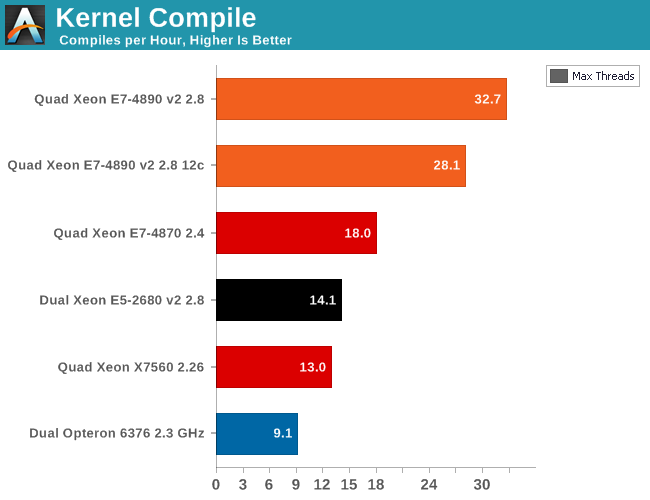The Intel Xeon E7 v2 Review: Quad Socket, Up to 60 Cores/120 Threads
by Johan De Gelas on February 21, 2014 6:00 AM EST- Posted in
- IT Computing
- Intel
- Xeon
- Ivy Bridge EX
- server
- Brickland
Linux Kernel Compile
A more real-world benchmark to test the integer processing power of our quad Xeon server is a Linux kernel compile. Although very few people compile their own kernel, it gives us a good idea how the CPUs handle a complex build.
To do this we have downloaded the 3.11 kernel from kernel.org. We then compiled the kernel with the "time make -jx" command, where x stand for the maximum amount of threads that the platform is capable of using. To make the graph more readeable, the number of seconds in wall time was converted into the number of builds per hour.

The flagship SKU is almost twice as fast as the previous E7 platform and 2.5 times faster than the Xeon X7560.
It is interesting to note that Xeon 8857-V2 (simulated by the E7-4890 v2 with three cores disabled) will be about twice as fast as the Xeon E5-2680 v2 and delivers almost 90% of the performance of the flagship at 60% of the price. This may be a good option to help hard working developers be more productive and happy?
Of course, we wil be the first to admit that this is a niche market. Let's take a look at some software this platform is built to handle: SAP ERP.










125 Comments
View All Comments
Kevin G - Friday, February 21, 2014 - link
And a quick addition:There will indeed be a quick adoption to Haswell-EX not because of AVX2 or DDR4 but rather transactional memory support (TSX). For the large databases and applications these systems are targeted at, TSX should prove to be helpful.
TiGr1982 - Friday, February 21, 2014 - link
I agree, TSX should make a lot of sense for these E7's - they have a huge core count and huge shared memory at the same time.Schmide - Friday, February 21, 2014 - link
I think your L3 latency numbers are off. I think typical Intel L3 latencies are 30-40 clocks ~3-4ns.Schmide - Friday, February 21, 2014 - link
Oops my bad i miss used the calculator. Ignore.dylan522p - Friday, February 21, 2014 - link
No power consumption numbers?JohanAnandtech - Saturday, February 22, 2014 - link
Coming...we had to run lots of test in parallel, so it was not possible to make sure all systems were similar. Also we should test with workloads that require a lot more memory to get an idea.mslasm - Friday, February 21, 2014 - link
Note that E7-8857 v2 has 12 cores but no HT, so only has 12 threads as well (see http://ark.intel.com/products/75254/Intel-Xeon-Pro... Thus it is not equivalent to a 3Ghz E7-4860V2, as 4860 has HT for a total of 24 threadsAlso, there must be a typo either in the graph or in the text on the "single thread" integer performance test: "Opteron ... at 2.4GHz would deliver about 2481 MIPs", while - according to the graph - it already delivers 2636 @ 2.3Ghz.
JohanAnandtech - Saturday, February 22, 2014 - link
Good point. There is little gain from HT in OpenFoam, but it will influence the LZMA benchmarks. So the Openfoam findings are still valid, but not the LZMA. The kernel compile is somewhat in between.JohanAnandtech - Saturday, February 22, 2014 - link
I will rerun the benchmarks without HT to check.mslasm - Saturday, February 22, 2014 - link
Thanks! I did not mean to imply HT matters "a lot", but it may influence some (and I admit I don't know much about how your benchmarks behave, other than parallel LZMA which I worked a lot with) - so it just does not sound right to outright call it equivalent, and I wish AT only has statements anyone can just trust :)